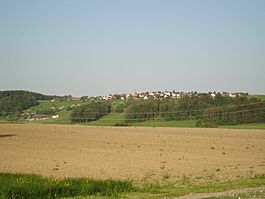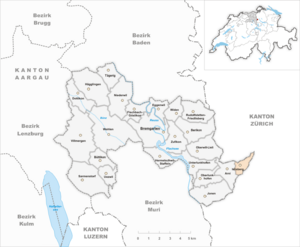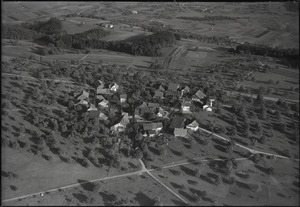Islisberg facts for kids
Quick facts for kids
Islisberg
|
||
|---|---|---|
 |
||
|
||
| Country | Switzerland | |
| Canton | Aargau | |
| District | Bremgarten | |
| Area | ||
| • Total | 1.66 km2 (0.64 sq mi) | |
| Elevation | 680 m (2,230 ft) | |
| Population
(Dec 2020 )
|
||
| • Total | 643 | |
| • Density | 387.3/km2 (1,003/sq mi) | |
| Postal code |
8905
|
|
| Surrounded by | Aesch bei Birmensdorf (ZH), Arni, Bonstetten (ZH), Hedingen (ZH) | |
Islisberg is a small town, also called a municipality, in Switzerland. It is located in the Bremgarten area within the canton (like a state) of Aargau.
Contents
History of Islisberg
Islisberg was first mentioned in old records in 1185, but it was called Nidolperhc back then. Later, in 1305, it was known as Isbolzberg. In the 1200s, the powerful Habsburg family controlled the area. Important landowners in the village included Muri Abbey and other monasteries.
In 1414, the nearby town of Bremgarten gained the right to handle local legal matters in Islisberg. This right lasted until 1797. After 1415, the city of Zurich was in charge of more serious legal cases for the region, including Islisberg.
Chapel and Schools
A chapel was built in Islisberg between 1360 and 1370. In 1937, it was dedicated to St. Anthony of Padua. Catholic residents of Islisberg belong to the parish (church community) of Lunkhofen, while Protestant residents are part of the Bremgarten-Mutschellen parish.
Education started early in Islisberg. A winter school opened in a dairy building in 1811. Later, a proper schoolhouse was built in 1869. A brand new school building opened in 2000.
From Farms to Homes
Islisberg was originally a farming village. However, by the early 2000s, only four farms remained. The town is now growing as a place where people live who work in the larger city area of Zurich.
From 1803 until 1982, Islisberg was part of a bigger municipality called Arni-Islisberg. In 1983, it became its own separate municipality.
Geography of Islisberg
Islisberg covers an area of about 1.7 square kilometers (0.65 square miles). Most of this land, about 69%, is used for farming. Forests cover 22% of the area. The remaining 8.9% is where buildings and roads are located.
The municipality is situated in the Bremgarten district, on the eastern edge of the Aargau canton.
Islisberg's Coat of Arms
The coat of arms for Islisberg has a special design. It shows a golden shield with a red lion walking diagonally across it. The lower part of the shield is blue and features a silver key also placed diagonally.
Population and People
As of 2022, Islisberg has a population of 670 people. In 2008, about 10.9% of the people living there were foreign nationals (people from other countries). Over the ten years before 2008, the population grew quite a lot, by about 61.9%.
Most people in Islisberg speak German (94.1%). English is the second most common language (2.7%), followed by Dutch (0.7%).
Age Groups in Islisberg
In 2008, the population of Islisberg included:
- Children (0-9 years old): 12.8%
- Teenagers (10-19 years old): 11.4%
- Young adults (20-29 years old): 10.6%
- Adults (30-39 years old): 15.5%
- Adults (40-49 years old): 21.2%
- Adults (50-59 years old): 13.2%
- Seniors (60-69 years old): 8.3%
- Seniors (70-79 years old): 4.5%
- Seniors (80-89 years old): 2.4%
- Seniors (90 and older): 0.2%
Homes and Housing
In 2000, about 57.1% of the homes in Islisberg were owned by the people living in them. In 2008, there were 87 single-family homes, making up 39% of all homes and apartments. There were only 4 empty apartments, meaning a very low vacancy rate of 1.8%.
Education in Islisberg
Swiss people are generally well educated. In Islisberg, about 85.3% of adults (aged 25 to 64) have completed higher education, like university or a specialized college. In the 2008/2009 school year, 60 students attended primary school in the municipality.
Historical Population Growth
The population of Islisberg has grown over the years:
| Historical population | ||
|---|---|---|
| Year | Pop. | ±% |
| 1980 | 157 | — |
| 1990 | 259 | +65.0% |
| 2000 | 405 | +56.4% |
Economy and Jobs
In 2007, Islisberg had a low unemployment rate of 1.87%. This means most people who wanted jobs had them.
Types of Jobs
- Primary Sector: In 2005, 21 people worked in the primary sector, which includes jobs like farming. There were 8 businesses in this area.
- Secondary Sector: 5 people worked in the secondary sector, which involves manufacturing and construction. There were 3 businesses in this sector.
- Tertiary Sector: 30 people worked in the tertiary sector, which includes services like shops, offices, and healthcare. There were 7 businesses in this sector.
Commuting to Work
In 2000, 223 people lived in Islisberg and worked. Most of them (82.1%) traveled outside Islisberg for their jobs. Only 13 people came into Islisberg to work. About 12.3% of workers used public transportation, while 58.1% used a private car to get to work.
Religion in Islisberg
According to the 2000 census, 54.8% of the people in Islisberg were Roman Catholic. Another 25.9% belonged to the Swiss Reformed Church (a type of Protestant church).
See also
 In Spanish: Islisberg para niños
In Spanish: Islisberg para niños






